100 Years of Morehouse and 100 Blog Posts

The 100th blog post, what to do? 100 years in business, 100 blog posts, several papers, and technical articles along the way. Communication has changed from a switchboard phone to a handheld personal computer that can receive this message. From the proving ring to today's deadweight calibrating machines, calibration technology has also changed over the years. Lots of history, lots of learning, lots of education, lots of false starts, some abandoned, some quite successful, others not so much, and so much gratitude to all.
Many of you have been with Morehouse for years, maybe decades, and all I can say is that you have enriched our lives. From past employees, owners, and customers, you all have shaped who we are today, and for that, I thank you. Thank you for your hard work, your mistakes that created headaches, those headaches that helped us learn and become better, your trust, and your help in making us always want to be better.
So, for our 100th post, I thank you all. May we continue this journey together, and as for the ups and downs; you all have played a part in this journey, and we look forward to continuing it. Below is a list of some of my favorite blog posts followed by pictures of our history over the last 100 years.
Load cell calibration: What does “Traceable to NIST” really mean?
Making a statement of compliance: The three main reasons calibration laboratories fail to get things right
Measurement Risk - What you need to know about your calibration provider. You may not be getting what you really need!
The Top 5 costly calibration mistakes for force measurements
Top 3 ASTM E74 Load Cell Calibrations Mistakes
Why a 4:1 T.U.R. is not enough: The importance of analyzing the probability of false accept risk
Without the Right Adapters a Force Calibration Technician is Nothing Short of Being Called a Miracle Worker
Using Mass Weights to Calibrate Force Devices Can Result in a Large Measurement Error
100 Years of Morehouse and Some Interesting Pictures
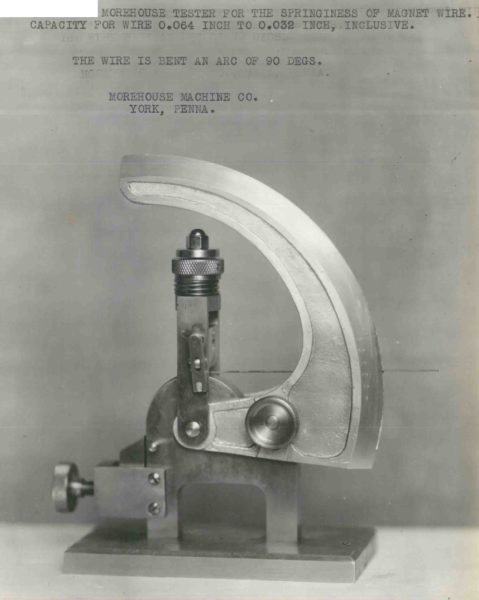
Morehouse Springiness Tester circa 1920's I believe about a dozen were sold.
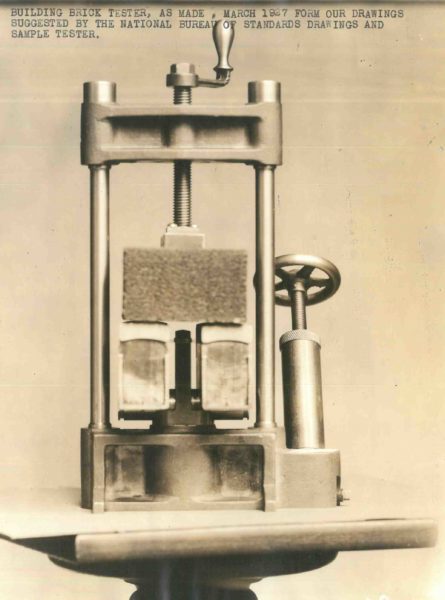
1927 Morehouse Brick Tester... What could have been our foray into the testing industry? There wasn't much of a market there 🙂
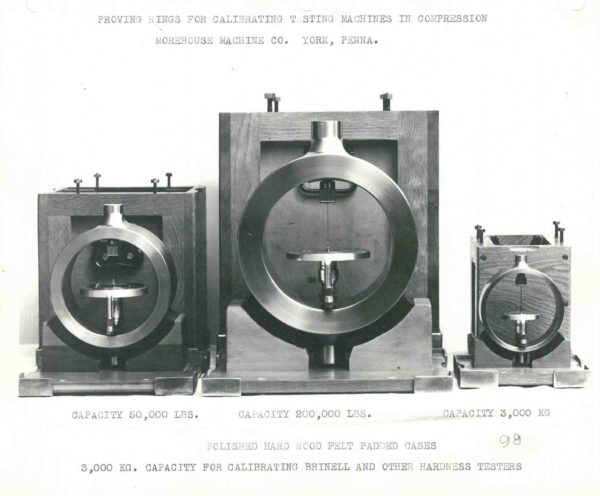
Instead, circa 1930's we decided to make and refine the greatest force instrument to calibrate testing machines.
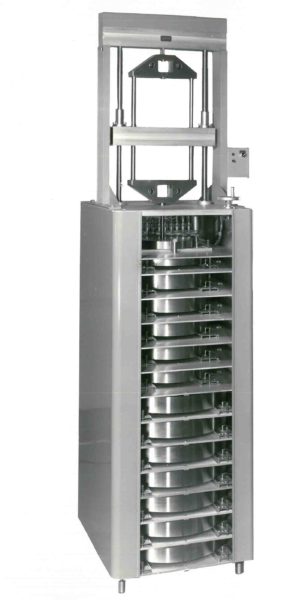
And by the 1950s, what would be used to calibrate the Proving Rings, Morehouse Deadweight Machines, of course?
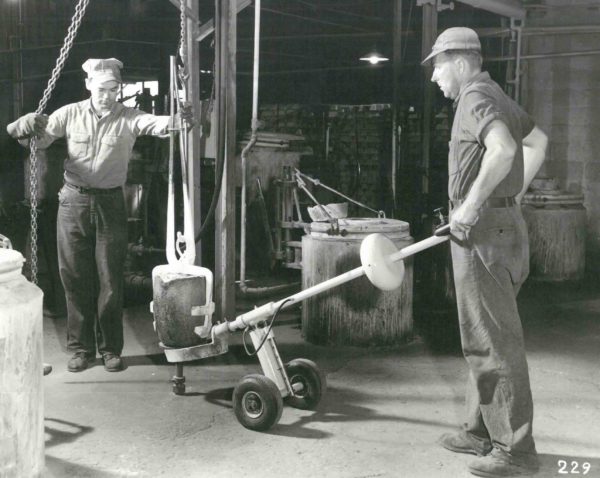
The 1960s brought the Unipour, which sold maybe 1 unit. The rumor was that the person who tested it was too short, and it failed.
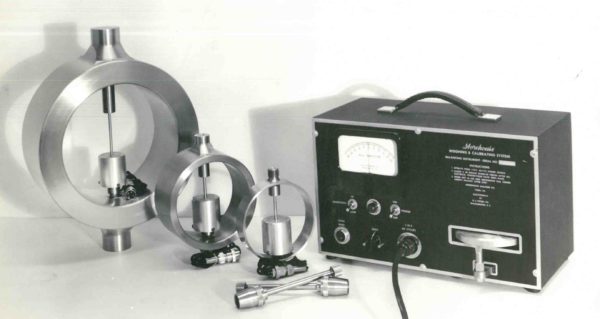
The 1960s brought the Morehouse semi-digital balancing instrument proving ring.
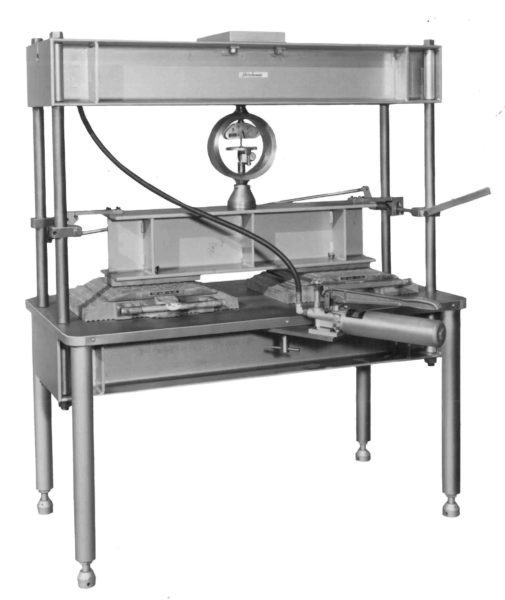
A Wheel Load Weigher Machine used to Calibrate Truck Scales circa the 1970s

Enter the digital revolution of the 1980s and Morehouse Digital Ring Force Gauges.
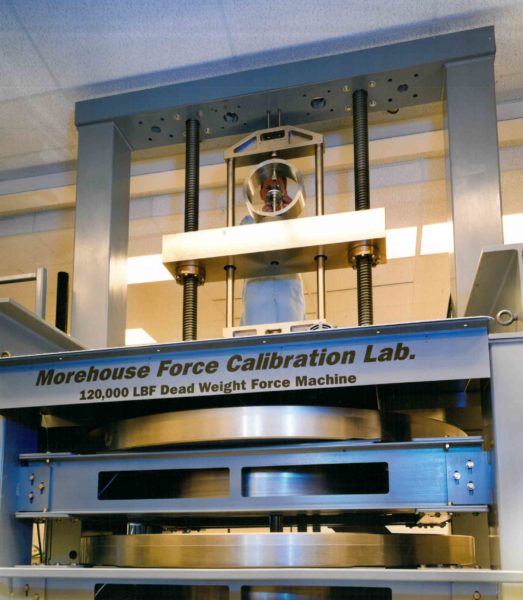
In 2004, Morehouse built a 120,000 lbf deadweight machine with an achieved uncertainty of 0.0016 % of applied force.
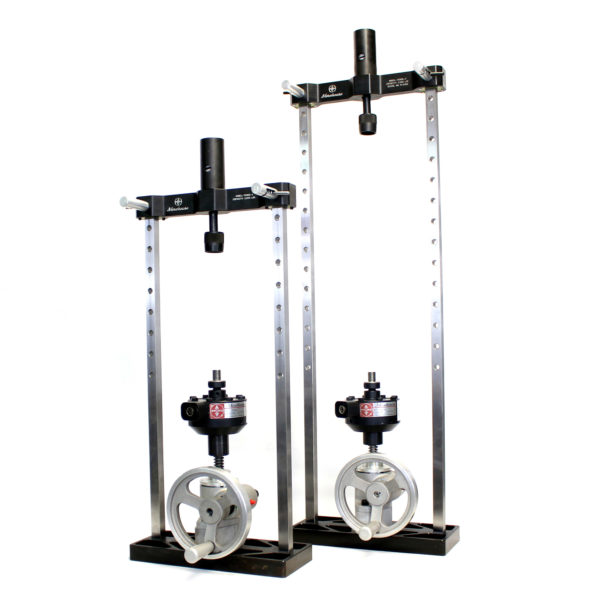
2017 A Morehouse Portable Calibrating Machine. This product has been part of our continuing designs, where we are now developing two to four new products per year that meet customer needs.
Here at Morehouse, we believe in changing how people think about Force and Torque calibration. We challenge the "just calibrate it" mentality by educating our customers on what matters, what causes significant errors, and focus on reducing them. Morehouse makes simple-to-use calibration products. We have certainly had some misses throughout the years; however, we build fantastic force equipment that is plumb, level, square, rigid, and provide unparalleled calibration service with less than two-week lead times.
Contact us at 717-843-0081 to speak to a live person or email info@mhforce.com for more information.
The other 99
- 3 Rules to Reduce Your Measurement Risk
- About Morehouse
- AC Versus DC (mV/V) Differences in Load Cell Meters Using a Load Cell Simulator
- Adjusting lbf (pounds-force) weights for gravity at the point of use
- Aircraft and Truck Scale Calibration
- ASTM E74 and Accuracy Statements: Why An Accuracy Statement Does Not Belong on Every Calibration Certificate
- ASTM E74-18 Changes
- ASTM E74 Calibration Procedure Simplified
- ASTM E74 IS NOT THE SAME AS ISO 376
- ASTM E74 Primary, Secondary and Working Standards Explained
- Automatic Deadweight Load Cell Calibration Instrument for Improved Force Calibration Results
- Battery life and voltage may impact your calibration results
- Calculating Calibration and Measurement Capability (CMC) using the ASTM Lower Limit Factor (LLF)
- Calibrate Instruments ON-SITE With a Morehouse 2000 lbf Portable Calibrator
- Calibrating Multi-Axis Load cells in a Morehouse Calibrating Machine
- Calibration and Measurement Capability (CMC) Workbook For Force - ASTM E74 Uncertainty
- Calibration Intervals - When is it time to recalibrate?
- Choosing the Right Indicator for your Load Cell System
- Confidence in Your Results Starts with Morehouse Accurate Load Cell Calibration Service
- Converting an mV/V load cell signal into Engineering Units: Why this may be the most accurate and cost-effective way to use a calibration curve.
- Cosine Error Should be Considered in any Torque Measurement Process
- Does a Backup Meter for Your Load Cell System Make Sense?
- Does resolution need be in an uncertainty budget?
- Evaluating the "Usefulness" of force calibration equipment
- Excellence In Innovation - Morehouse Instrument Company 2016 Finalist
- Force and Uncertainty Training
- Force Applications for Mass Reference Standards
- Force Measurement Error - Thread Loading In Compression
- Force Measurement Error – Time Interval Between Two Successive Loadings
- FORCE SAFETY - FORCE SAFETY GUIDE WHEN USING FORCE MEASURING EQUIPMENT IN VARIOUS APPLICATIONS
- Good Force Measurement Practice - Load Cell with Flat Base
- Good Force Measurement Practice - Stop using 4-wire systems and switch to 6-wire systems
- Guest Blog: Know a Torque Wrench Better with this Ultimate Guide
- Guidance on Uncertainty Budgets for Force Measuring Devices Part 1. Why Do We Need a Guidance Document?
- Guidance on Uncertainty Budgets for Force Measuring Devices Part 2. Calculating Uncertainty in Accordance with the ASTM E74 Standard
- Guidance on Uncertainty Budgets for Force Measuring Devices Part 3a. Calculating Uncertainty for Force Measuring Devices for Measurement or Verification of Force Using Non-Linearity
- Guidance on Uncertainty Budgets for Force Measuring Devices Part 4. Calculating Uncertainty for Force Proving Instruments Calibrated to ISO 376
- How do you know if your device is “In-Tolerance”? Why the location of the measurement is more important than you may realize.
- How to Calculate the Resolution of a Load Cell
- How to Calculate the Uncertainty of a Deadweight Primary Standard Machine
- How to Calibrate Button Load Cells and Achieve Good Results
- How to Calibrate S-Beam or S-Type Load Cells
- How to Convert Force to Mass
- How to Lose a lot of Money on Annual Load Cell Calibrations
- How to make your load cells perform better - The advantages of Installing an integral threaded adapter
- Keep your force measurement system in control with Statistical Process Controls (SPC) and 5 in 1 solution
- Load Cell Alignment Plugs Proper Use
- Load cell calibration: What does “Traceable to NIST” really mean?
- Load Cell Creep
- Load Cell Measurement Error - If a load cell is to be used to make descending measurements, it must be calibrated with a descending range
- Load Cell Measurement Error - Top Block Adapter Hardness and Flatness
- Load Cell Measurement Error - What you need to know about having a load cell calibrated at a high and low range
- Load Cell Stability – How It Can Kill Your Uncertainty Budget
- Load Cell Transitioning from one mode to another. Does it make a difference?
- Load Cell Types - Choosing the Right Load Cell for Your Application
- Making a statement of compliance: The three main reasons calibration laboratories fail to get things right
- Measurement Risk - What you need to know about your calibration provider. You may not be getting what you really need!
- Measurement Risk Lottery
- Measurement Uncertainty Calculations and how the Measurement Hierarchy works in relation to measurement uncertainty
- Morehouse 600K Light Weight Load Cell System for ASTM E4 Calibration of Concrete Machines
- Morehouse 7 Step Process For Troubleshooting A Load Cell
- Morehouse Force Measurement Insider
- Morehouse Instrument Company offers Digital Force Gauges and retrofit options for existing Morehouse analog-type force gauges
- Morehouse Has an App to Convert Force to Mass, Mass to Force and it uses NOAA so it should be known to within 5 ppm!
- Morehouse ISO 376 Calibration Certificates
- Morehouse Load Cell Amplifier for Controllers (LAC) Can Improve System Performance by a Factor of 10
- Morehouse Proving Ring Tare Load Correction
- Morehouse Training, Sessions, and Presentations at NCSLI 2018 in Portland August 26 – 30
- Morehouse Versatile Cable Tensiometer and Force-Measuring Instrument Calibrator
- Preparing Measurement and Test Equipment (MT&E) For Shipment
- Presenting a Tutorial at NCSL International
- Proving Ring Tare Load Correction Proof
- Pull your force calibration data from anywhere using your smartphone.
- Recommendations for Specifying ASTM E74 Calibration Services
- Single Measurement Bliss
- Specifying a Tolerance, the Difference Between Percentage of Indicated Value vs % of Full-Scale Output
- Tensile Calibration Adapter Breakthrough! Morehouse Force Calibration Adapters for Calibration of Lifting Devices such as Crane Scales, Tension Links, and Dynamometers
- Tension Link Good Measurement Practice
- The 3 Key Changes to ISO 9001 Compliance and What This Means for Force and Torque Instrumentation
- The Importance of Considering Reproducibility in the Measurement Process Uncertainty
- The Importance of Torque Control
- The proper way to express torque units is lbf·ft or N·m.
- The Top 5 costly calibration mistakes for force measurements
- Tips from the Cal Lab – Point of Use to Save Time
- Tips From The Cal Lab - Setup Reduction With Morehouse Quick Change Tension Members and Adapters
- Top 3 ASTM E74 Load Cell Calibrations Mistakes
- Top 5 Common Force Measurement Errors
- Torque Formulas and Conversions
- Unbolting Load Cells May not Produce Repeatable Calibration Results
- Understanding ISO 376
- Understanding the Calibration Coefficients for Load Cells and Other Force-Measuring Devices
- Universal Calibrating Machines versus Universal Testing Machines - These machines are different
- Using Mass Weights to Calibrate Force Devices Can Result in a Large Measurement Error
- What happens when you overshoot a test point?
- What is Accuracy? Can we trust the manufacturer's specifications
- What Makes a Force Calibration Machine Fit for Use?
- WHY A 4:1 T.U.R. IS NOT ENOUGH: THE IMPORTANCE OF ANALYZING THE PROBABILITY OF FALSE ACCEPT RISK
- Why Measurements Matter - Force Transducer Testing and NASCAR
- Without the Right Adapters, a Force Calibration Technician is Nothing Short of Being Called a Miracle Worker
Morehouse Conclusion
We sincerely thank all of you for helping Morehouse stay in business past 100 years. We are constantly striving to provide our customers the best value. If you have any questions, please contact Morehouse @ 717-843-0081
If you enjoyed this article, check out our LinkedIn and YouTube channel for more helpful posts and videos.
#Morehouse


